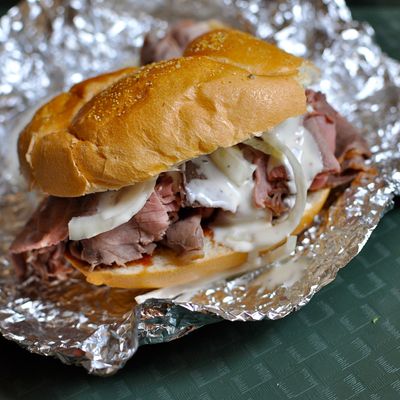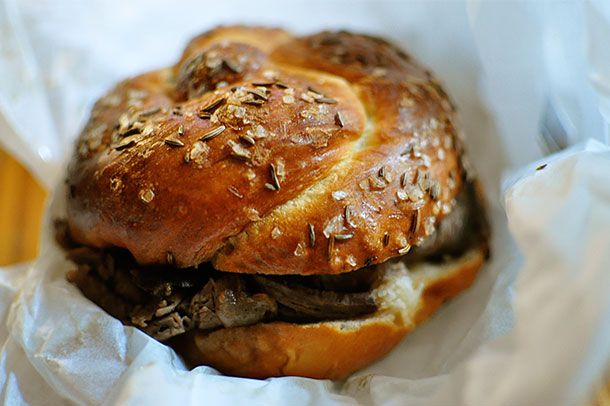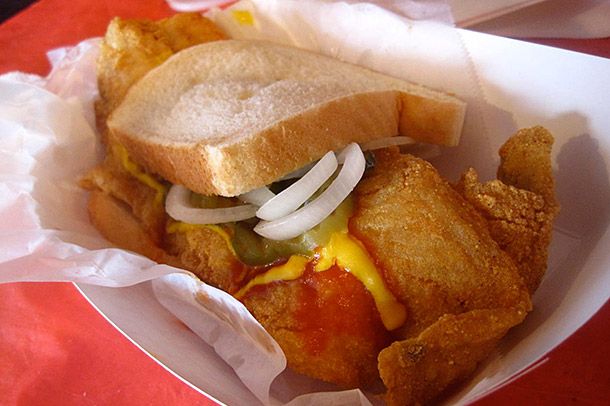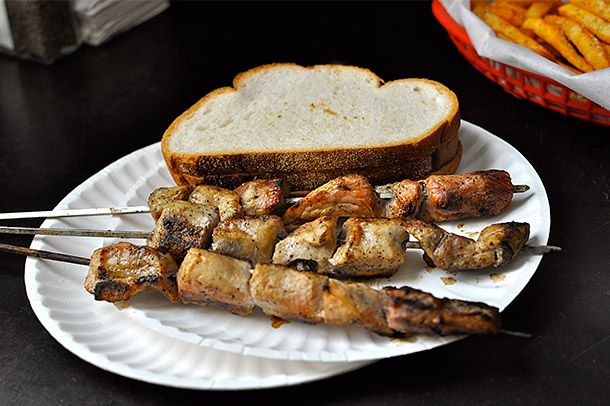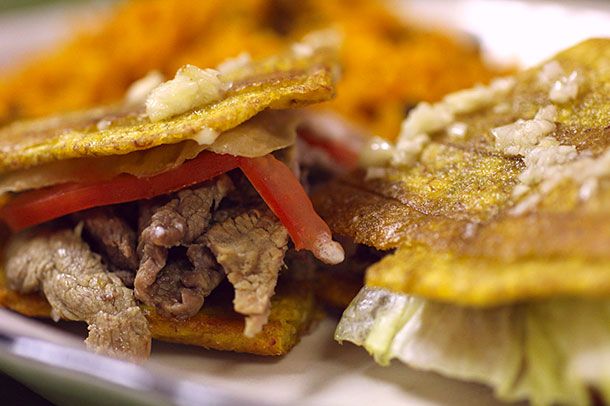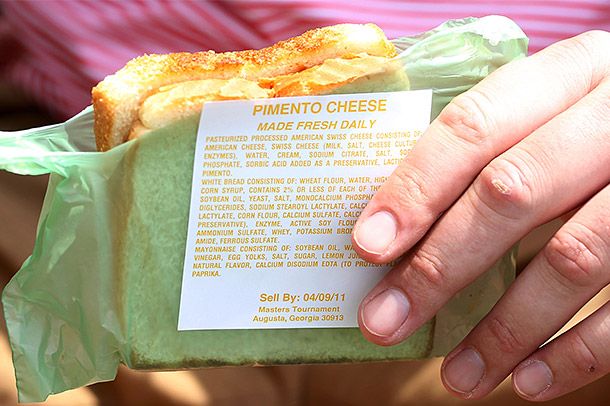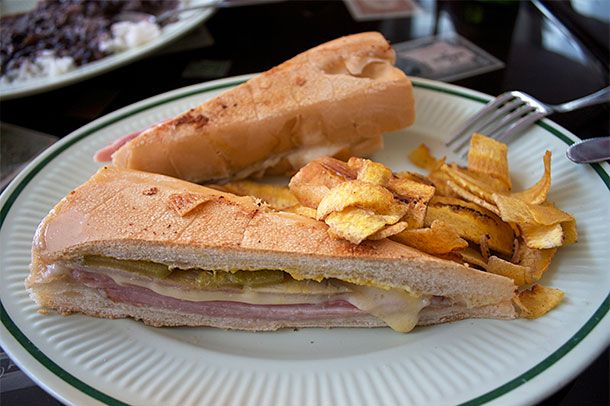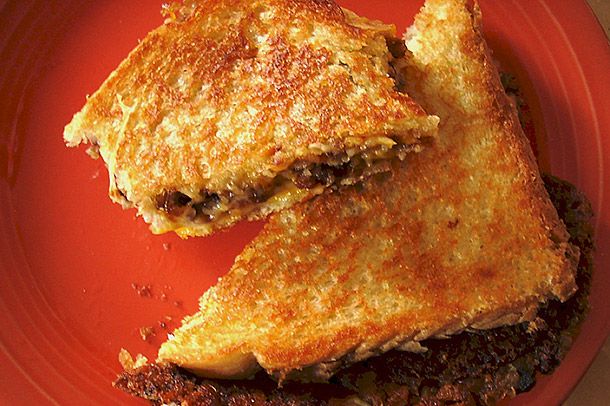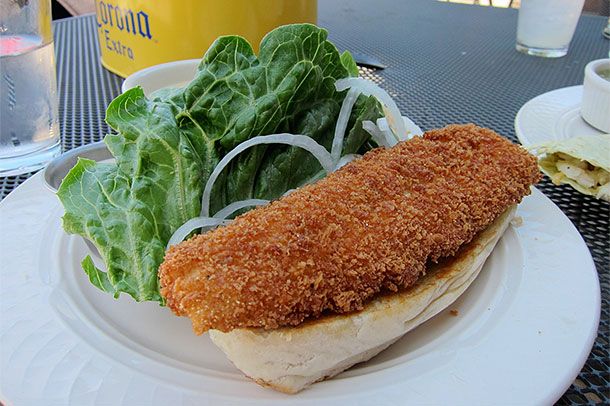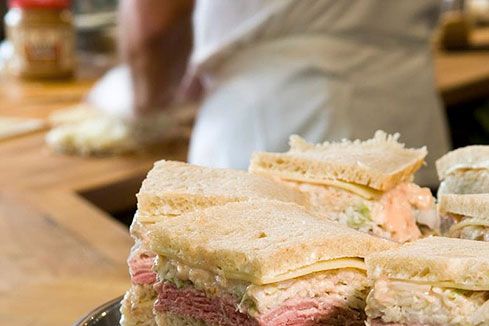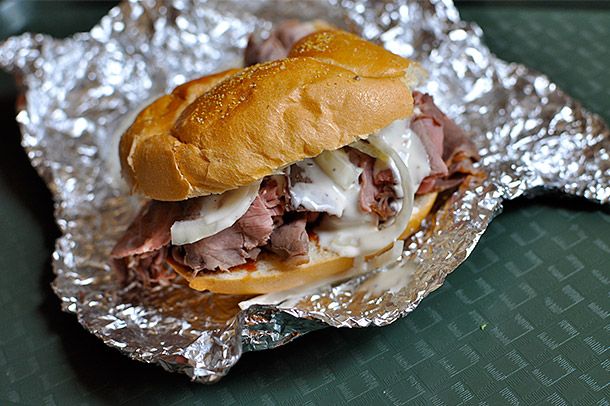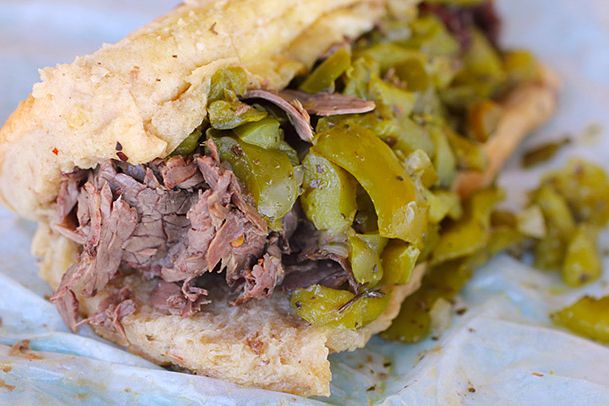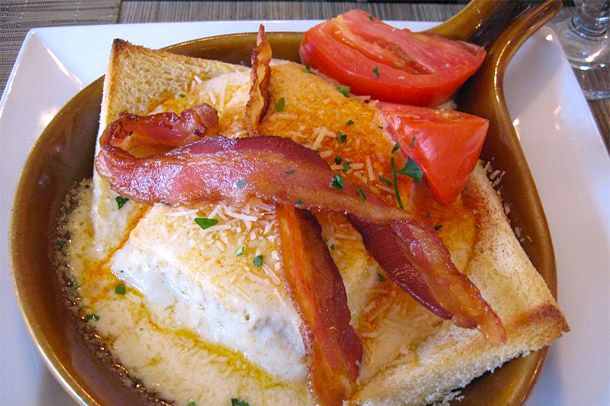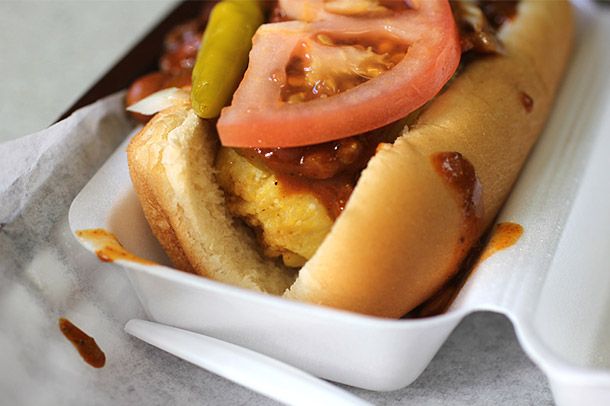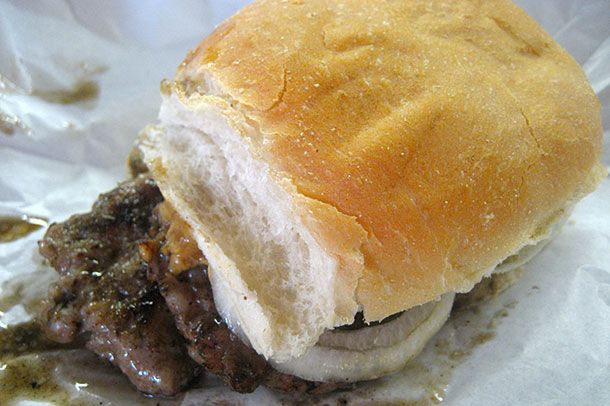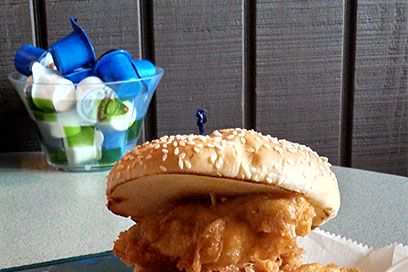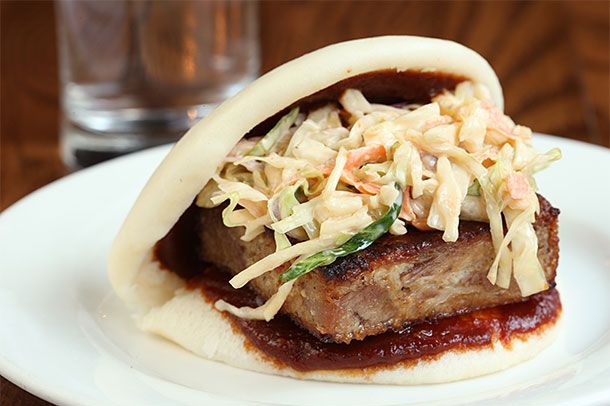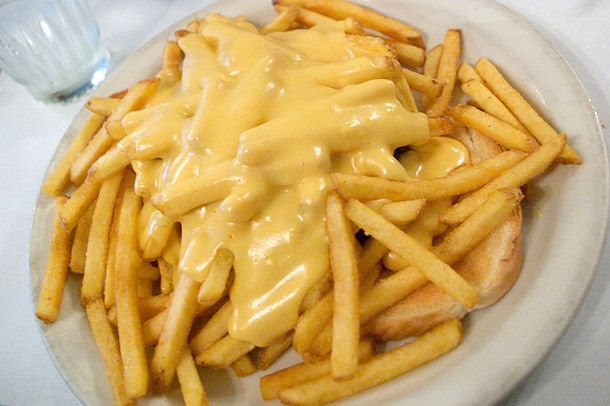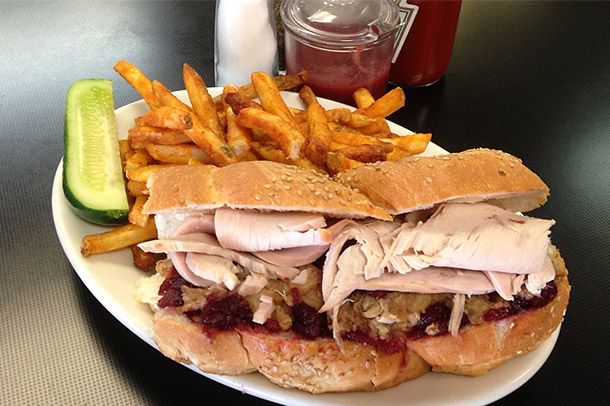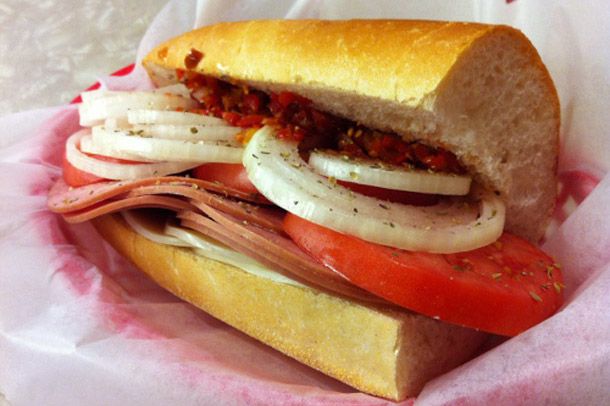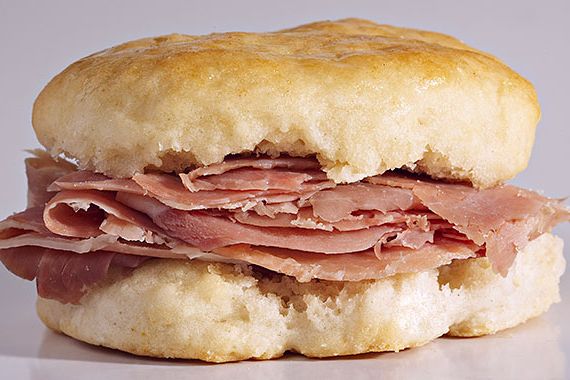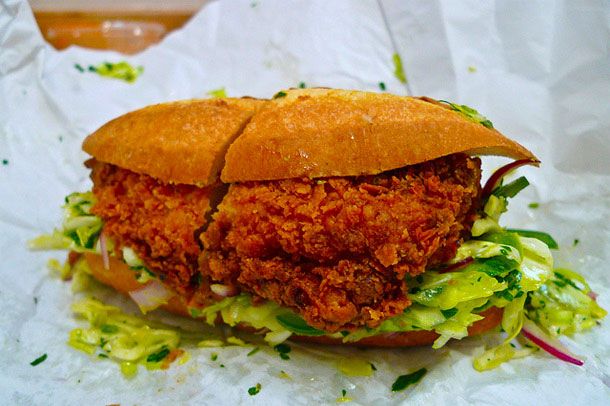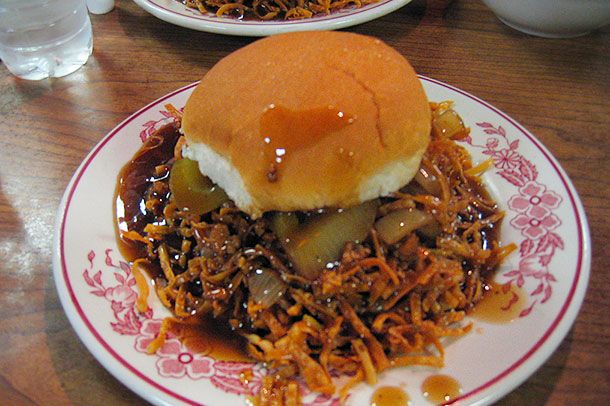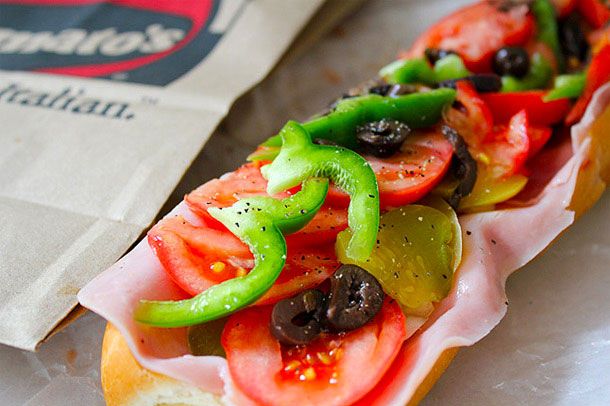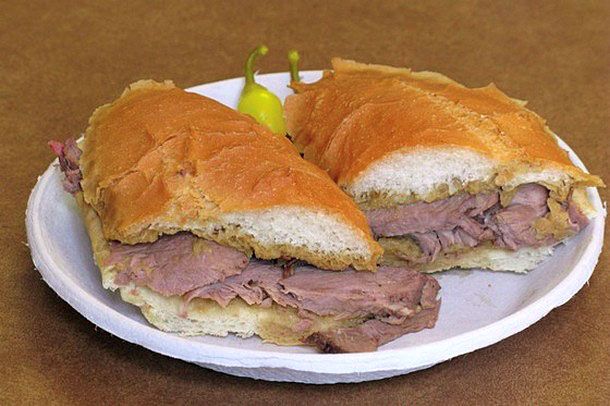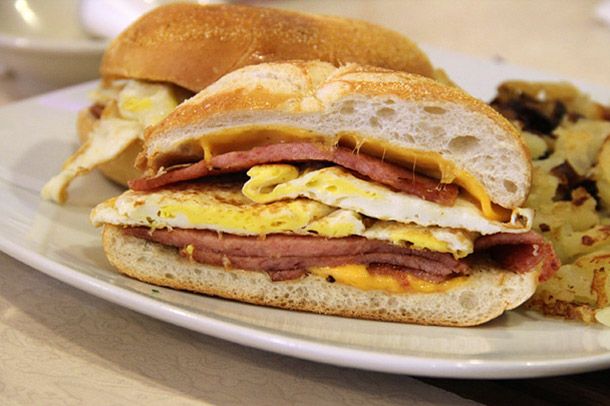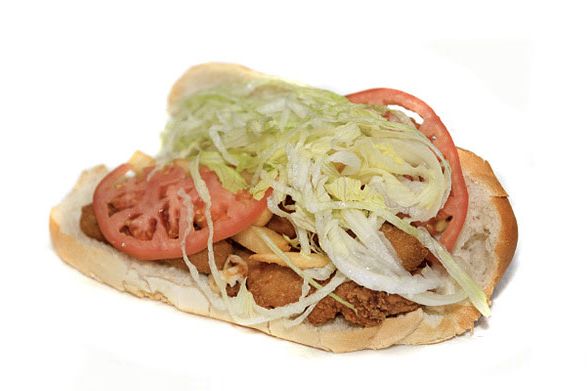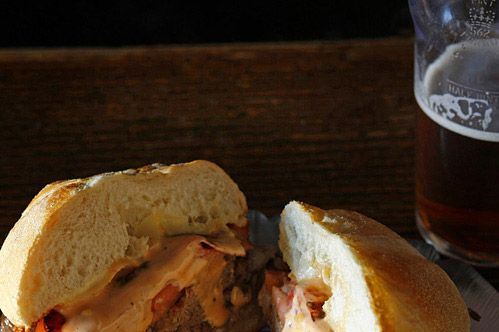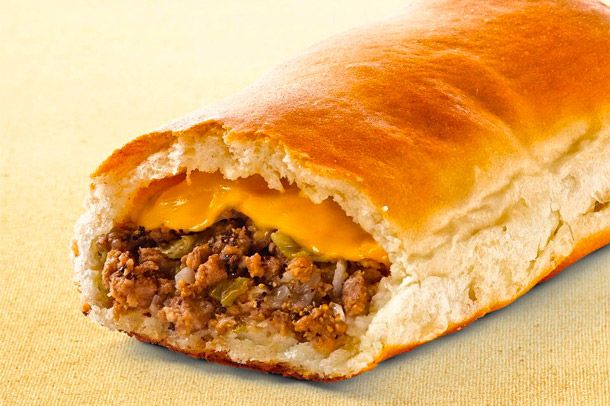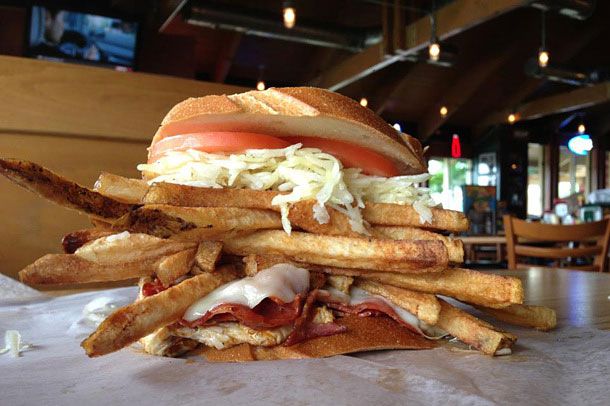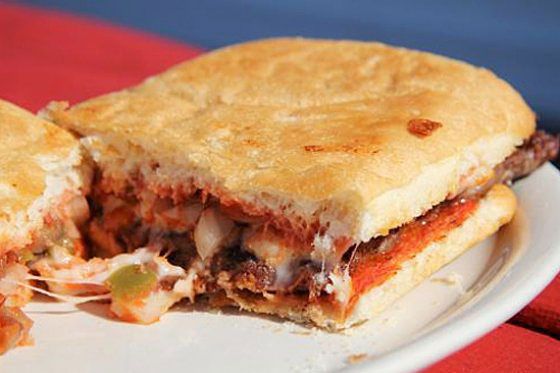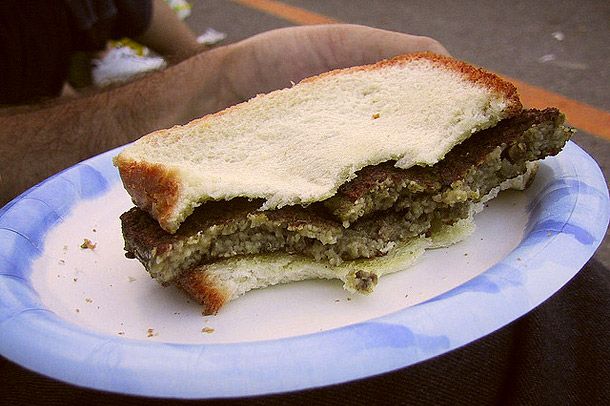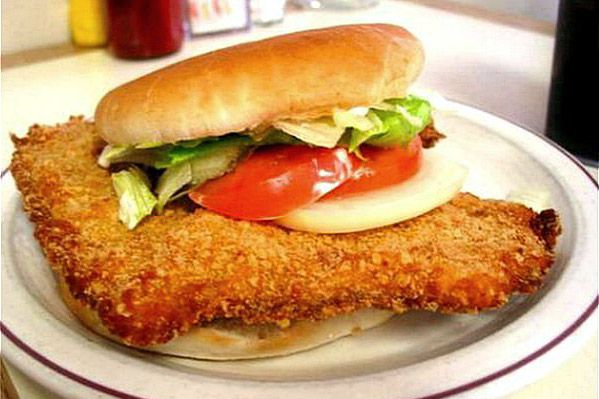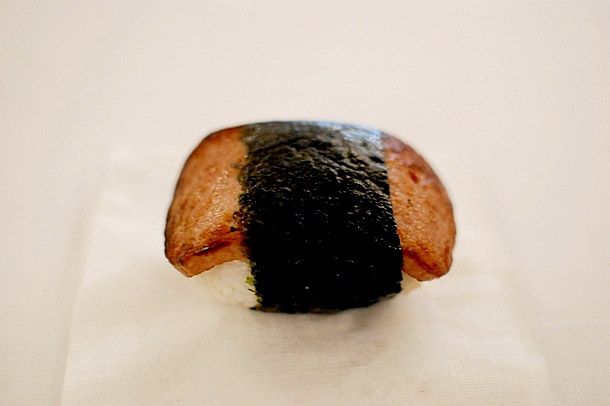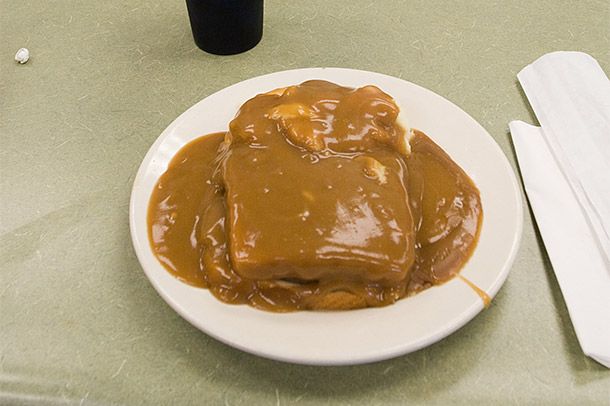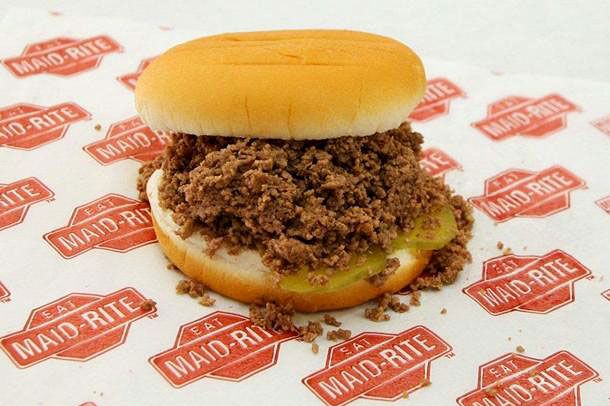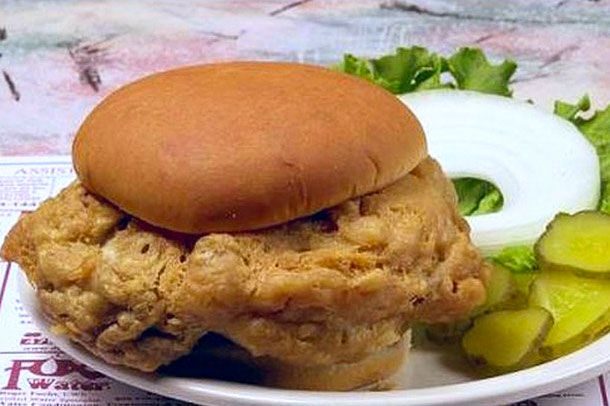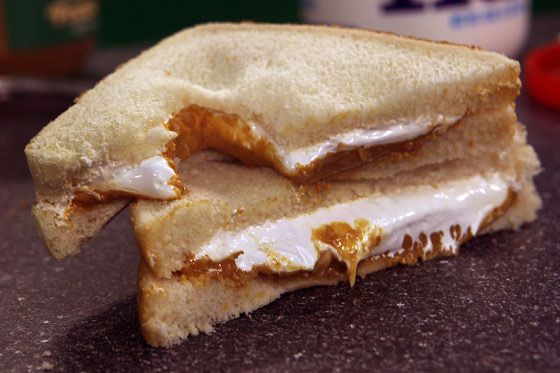Pit beef, from Baltimore.
America is a regional country: Food that’s core to the identity of one place — chili on spaghetti in Cincinnati, Spam on everything in Hawaii, Kool-Aid pickles in the South — is treated as nothing more than an oddity elsewhere. With that in mind, Grub Street set out to track down all of the country’s hyper-regional sandwiches: individual creations that, for one reason or another, seem to exist only in particular pockets of America.
To be clear, there are some things you won’t see here: po’boys, lobster rolls, muffulettas, grilled cheese, peanut butter and jelly, cheesesteaks, club sandwiches, Dagwoods, burgers, patty melts, or any sandwich that consists of simply placing some other kind of regional specialty — brisket, pulled pork — on bread. Those are the chart-topping hits of the sandwich world; this list is about the deep cuts.
The country is full of weird, wonderful creations that you’ve probably never heard of unless you live in their natal home: Gut-busters like the Midwest’s horseshoe (an open-faced sandwich covered with cheese fries), upstate New York’s beef on weck (named for its carraway-studded roll), or even chow mein sandwiches from Fall River, Massachusetts (exactly what they sound like).
Some of the sandwiches on this list have facsimiles outside their places of origin; others are only to be found in the areas where they were invented. They may differ wildly in concept, but that’s the whole point — the thing that all of these sandwiches do have in common is a fan base in some particular neck of the woods, and the potential to grow those devoted fans all across America.
The Region: Buffalo area; Western New York
Where to Get It:
Schwabl’s (since 1837!),
Charlie the Butcher,
Eckl’s
A workhorse sandwich of working-class German immigrants in upstate New York, the beef on weck is as much about the coarse salt and caraway-crusted kümmelweck roll on which it is served as it is about the top round, which is roasted rare, rested, sliced, and served with jus. Purists demand sliced pickles and horseradish sauce.
The Region: Nashville
Where to Get It:
Eastside Fish,
Bolton’s Spicy Chicken & Fish,
Eds Fish & Pizza House
Plain white bread, a liberal sprinkling of cayenne pepper, and a breaded and fried piece of white fish make up this Southern specialty. It’s a variation of the spicy hot chicken sandwich, which became popular in the seventies. Even when you request this sandwich as “mild,” it should still come out super spicy — and the flavor’s often magnified by hot sauce and paprika. Toppings sometimes include cheese and onions.
The Region: Binghamton and Endicott, New York
Where to Get It:
Lupo’s,
Sharkey’s, and
Stu’s Place
The central component of this sandwich, which even has its own namesake celebration every August, is cubed meat (chicken or lamb, usually) that’s been left to marinate for some inordinate amount of time. Its name is derived from the Italian spiedini, and true to form, meat for spiedies is grilled on skewers and served directly on Italian bread, or sometimes a roll. Spiedies have long been found exclusively in central New York, but a
somewhat heretical version is now served at NYC restaurant Brooklyn Bird.
The Region: New York City (and its suburbs)
Where to Get It: Any deli or coffee cart.
There’s nothing inherently New York–centric about this creation: It’s a quick-fried egg and cheese (American, preferably), maybe some bacon or sausage, on a big squishy kaiser roll, wrapped in foil and sold for about two bucks. They’re simple, belly-filling, and ubiquitous — a common cure for the standard Manhattan hangover. But why is such a simple creation so hard to find outside of New York? Perhaps it’s because of the city’s unique bodega culture, or perhaps it’s because New Yorkers, surrounded by amazing bars and restaurants and able to take subways and cabs instead of driving after a night on the town, just have the most severe hangovers to deal with.
The Region: Baltimore area
Where to Get It:
The Roost Lake Trout,
Lake Trout
It’s fished from deep and frigid Atlantic waters up to Canada all the way down to Virginia and it’s actually whiting, but no matter: Eat it deep-fried and essentially unadorned with white bread. You may get a few pin bones, sure, but ordered with a mess of generic fries, hot sauce, and possibly some stewed collards on the side with this Baltimore-area specialty, you likely won’t mind one bit.
The Region: Puerto Rican neighborhoods in Chicago
Where to Get It:
Borinquen,
Papa’s Cache Sabroso,
Ponce
The origins of many regional specialties are unknown or disputed. Not so with the Jibarito (“hillbilly,” roughly), which you can still order from the hands of the man who invented it. Around 1996, Borinquen owner Juan Figueroa read an article in a Puerto Rican newspaper about using plantains fried as stiff as wallboard in place of bread. He put steak, gooey cheese, mayo, lettuce, tomato, onion, and fried garlic between the plantains — summing up the entire Puerto Rican immigrant experience in a single sandwich. Figueroa’s invention quickly spread to other Puerto Rican restaurants around Chicago, though ironically it remains little known back home.
The Region: Southeast USA
Where to Get It:
Buttermilk Kitchen,
Butcher & Bee,
Augusta National
The Augusta National Golf Club boosted the popularity of this Southern specialty by making it a tradition of the Master’s. For those who might not know, pimento cheese is a sharp, spreadable orange cheese that’s made with cheddar, mayonnaise, red chili peppers (pimentos), and at least a few secret ingredients throw in by whoever is making it. It goes particularly well with jalapeños, ham, mayo, and pickles. This year, the Master’s caused a controversy when it started using a local food supplier that left out an elusive ingredient. “PimentoGate” remains unsolved.
Photo: Jamie Squire/2011 Getty Images
The Regions: Miami, Tampa
Where to Get It:
Versailles,
Enriqueta’s,
Sarussi Cafe
The origins of this meaty sandwich (ham, roasted pork, Swiss cheese, pickles, mustard, and crusty Cuban bread) aren’t exactly clear, but it made its way to Florida in the late-1800s: Cuban cigar factory and sugar mill workers often ate it for lunch. Cuban bread is critical, which should be sliced horizontally, buttered or oiled, and toasted once it’s stuffed with ingredients. Tampa’s Cubans include salami, and sometimes even mayo, but Miami’s traditional version does not. The two cities have publicly battled over who has ownership over the sandwich.
The Region: Cincinnati
Where to Get It:
Bellevue Bistro,
Nectar,
The Rookwood
Goetta is a German-American breakfast sausage that’s made of ground meat and steel-cut oats. Some people actually refer to it as “Cincinnati caviar.” The scrapplelike food originated in the city in the early 1900s, when Germans settled there. It’s served as a breakfast sandwich and pairs nicely with fried eggs, cheese, syrup, and jelly. But this isn’t only a lowbrow sandwich ingredient: Cincinnati restaurants take pride in making their own goetta and like to dress it up with toppings like chipotle-lime hollandaise and bacon jam.
The Region: St. Louis, Missouri
Where to Get It:
Wong’s Inn,
Mai Lee,
Golden House
If modern Chinese-American egg foo young is somewhat of an immigrant riff on a more canonical Cantonese omelette, the St. Paul sandwich — which consists of an egg foo young patty made with meat and/or seafood, sprouts, eggs, soy sauce, and more served on plain white bread with pickles and lettuce — is an immigrant riff squared. Often appearing as its own section at Vietnamese and Chinese restaurants in St. Louis, this sandwich deserves a much broader fan base.
The Region: Minnesota
Where to Get It:
Tavern On Grand,
Victoria House,
The Blue Goose Inn
The walleye is Minnesota’s official state fish, and most bars and pubs in the area serve the deep-fried fish sandwich, which usually comes on a hoagie bun with traditional tartar sauce. Though it’s fried, the fish’s texture should still be soft and flaky. Some restaurants will grill or blacken the fish, but it’s best when fried and simply seasoned with salt and lemon.
The Region: South Orange and Millburn, New Jersey
Where to Get It:
Town Hall Deli,
Millburn Deli
This towering triple-decker has nothing to do with mystery meat or tomato sauce. Instead, at certain northern New Jersey delis, a sloppy joe is made with three slices of light rye, two house-roasted meats of your choice (roast beef and turkey is a popular combo, though tongue and pastrami are legitimate as well), Swiss cheese, coleslaw, and Russian dressing. At the Town Hall Deli, owner Tony Wonski — who says he invented the sandwich — uses super-secret homemade Russian dressing and brined coleslaw, made without mayonnaise. The result is juicy, tangy, crunchy, and absolutely nothing like the joes of our teenage cafeteria nightmares.
The Region: Baltimore area
Where to Get It:
Chaps Charcoal Restaurant,
Smoky’s,
Pioneer Pit Beef
Dry rubbed brisket or top round that’s been slow-roasted on a pit then sliced thin and served on a kaiser roll with raw onion and horseradish mayonnaise — that’s the gist of the original And while it may sound like a roast beef sandwich with a fancy name, devoted legions of pit beef fans will be happy to point out just how tricky the real thing is to pull off: Slice thickness is crucial, the rub is clutch, and though it may seem tempting, the addition of anything resembling barbecue sauce absolutely ruins it.
The Region: Chicago
Where to Get It:
Johnnie’s Beef, Elmwood Park,
Al’s Italian Beef,
Boston’s Italian Beef
Everyone knows Philly’s cheesesteak, but Chicago’s common man’s beef sandwich remains largely a local specialty. Simpler and less gaudy (i.e. no cheese, ever) than the Philly sandwich, it’s shaved beef in an Italian-seasoning broth, served with sweet or hot peppers on a Gonnella roll that is usually dipped in the jus (so the clock is ticking to eat it before it falls apart). What sets one stand apart from the next is not only the flavor of the broth but also the particular nature of the spicy giardiniera relish — which all of the best places make in house according to their own ancient and proprietary formulas.
The Region: Louisville and Lexington
Where to Get It:
The Brown Hotel;
Captain’s Quarters Riverside Grille
This open-faced sandwich originated at the Brown Hotel in Louisville in 1926 and has gotten plenty of airplay on Food TV in recent years. It’s crisped bread topped with turkey, tomato, and bacon, slathered in Mornay sauce (cheesy béchamel), and baked. It’s basically an Americanization of Welsh rarebit, and who can say no to bacon and cheese sauce? Some versions also add cheddar cheese and ham, but those would be inferior imitators.
The Region: South Side of Chicago
Where to Get It:
Johnny O’s,
Fat Johnnie’s,
The Hot Dog Guy
Researchers have found more mystery than history in trying to explain this south-side staple. It’s thought that the tamale, like the blues, came up to Chicago from the Mississippi Delta in the twenties. Putting one workingman’s cheap lunch (the tamale) on a bun as a substitute for meat (a hot dog), and coating it with another cheap lunch (chili) and all the toppings of a Chicago dog (onions, sport peppers, etc.), was probably a natural for the poor black south side in the Depression. But if that’s the case, why does it survive now almost exclusively in white south-side neighborhoods? And why is it called a mother-in-law, anyway? Because it was good enough for a mother-in-law living with you — or because it was guaranteed to cause indigestion?
The Region: Sheboygan, Wisconsin
Where to Get It:
Charcoal Inn,
Schulz’s,
Cruisers Frozen Custard and Jumbo Burgers
As Sheboygan is synonymous with bratwurst, its signature sandwich, the double brat, is synonymous with tailgating parties (and, it appears, coronary occlusion). You start with two brats — usually in encased sausage form, sometimes smashed into patties — which are preferably cooked over charcoal, though places that really do it that way are rare these days. You slap them both on a particular kind of bun called a Semmel roll in Germany (in Sheboygan, it’s called a “bun”). And you top them with onion, brown mustard, and finally — this being a dairy state — plenty of pure Wisconsin butter, seen here all pooled on the paper.
The Region: Northern Ohio
Where to Get It:
New Sandusky Fish Company,
Jolly Roger Seafood House,
Village Inn
You’ll find this fried-fish sandwich near Lake Erie. Perch is beer-battered or pan-fried and placed on a soft hamburger-style bun with lettuce, tomato, and onion. Ketchup, hot sauce, and tartar are all appropriate condiments. The fried-seafood sandwich actually isn’t so different from the walleye — no wonder people often compare the two.
The Region: New York City
Where to Get It:
Momofuku,
Baohaus,
Wong
Soft, fluffy steamed buns were a Chinatown staple for ages, but David Chang changed everything when, at the original Momofuku Noodle Bar, he stuffed bao with slow-cooked pork, hoisin, and cucumbers: The high-end Asian bun is now its own
full-fledged culinary category, with spots like Baohaus serving buns stuffed with fried chicken and Wong serving a $9.50 duck bun stuffed wtih confit and Chinese celery.
The Region: Springfield, Illinois
Where to Get It:
Maldaner’s,
D’Arcy’s Pint,
D&J Cafe
The favorite sandwich of Abraham Lincoln’s hometown, this combination of French fries, cheese sauce, and a hamburger patty or other meat on Texas toast has grown into a big, gloppy carbfest. That’s ironic, says culinary historian
Julianne Glatz, because it was invented in the twenties as elegant hotel food, with a slice off a bone-in ham (supposedly resembling a horseshoe) on bread, topped with fried potato slices and a complex Welsh rarebit sauce. She suggests Maldaner’s, which dates back to 1884, for a version that comes close to the relatively restrained original from the long-gone Leland Hotel — including what’s supposed to be the Leland’s original cheese sauce recipe.
The Region: New England
Where to Get It:
All Star Sandwich Bar,
Cardullo’s,
Mike’s City Diner
The Pilgrim, sometimes called a Gobbler or leftovers sandwich, is Thanksgiving between bread. Expect fresh roasted turkey (white or dark meat), cranberry sauce, and stuffing on a roll of your choice, usually doused with gravy. Mike’s City Diner sells about 50 Pilgrims each day, even during the summer. It’s best devoured with a fork and knife.
The Region: Norristown; Philly Suburbs
Where to Get It:
Lou’s Sandwich Shop,
Eve’s Lunch
Just as Italian immigrant workers gave rise to hoagies in South Philly, laborers in the industrial suburban burg of Norristown put Zeps on the map. Taking their name from the airships of the early twentieth century, the sandwiches are similar to hoagies but are smaller, layered with just one type of meat, do not include lettuce, and must be served on bread from nearby
Conshohocken Bakery. Many luncheonettes and sandwich shops throughout the region offer them, but Lou’s Sandwich Shop and Eve’s Lunch are generally regarded as the
Pat’s and Geno’s of the genre.
The Region: Virginia, Southeast USA
Where to Get It:
Carrot Tree Kitchens,
Calhoun’s Ham House
Every Saturday morning in Alexandria, Virginia’s Old Town neighborhood, the friendly folks from
Calhoun’s Country Ham set up a stand selling their justifiably famous ham biscuits. No frills here: just a cured, six-month-aged disk of ham on a sweet, diminutive roll, sold à la carte or by the dozen (some people buy trays). They’re usually eaten at cocktail parties, tailgates, or — furtively — in your car. Some home cooks add Swiss cheese or Dijon mustard, but we think they’re perfectly flavorful as is.
Photo: Len Rothman
The Region: Oakland, San Francisco, Los Angeles
Where to Get It:
Bakesale Betty,
Hi Tops,
Son of a Gun
Conceived first by Chez Panisse alum Alison Barakat at Oakland’s Bakesale Betty — which still sells up to 800 of these things a day — this boneless fried-chicken sandwich has spawned dozens of imitators. Vinny Dotolo of L.A.’s Animal and Son of a Gun once
named it as a favorite for Grub Street’s Food Chain in 2010, and subsequently created a version of his own; as did Jamie Lauren in creating the menu for Hi Tops sports bar in San Francisco. The buns may vary, but the elements are the same: crisp fried chicken breast filets piled atop spicy, acidic coleslaw (Barakat’s original is flecked with jalapeño), and aioli, with all the elements complementing each other as any great sandwich fillings should. Call it a modern classic, and the fanfare has not died down (see Bon Appétit’s
recent national roundup of sandwich shops for proof).
The Region: Fall River, Massachusetts
Where to Get It:
Evelyn’s Drive In
This sodium-saturated sandwich is unique to southeastern New England, particularly Fall River, New Bedford, and parts of Rhode Island. An acquired taste, it’s essentially a hamburger bun stuffed with crispy noodles, swimming with brown gravy. Many Fall River kids grew up eating it in school cafeterias. This might be frowned upon now, but you can still find the elusive sandwich at dives throughout the Fall River area. Natives say that it must be mixed with veggies — usually overcooked celery and onions — and topped with soy sauce. Thick-cut fries on the side are optional but encouraged.
The Region: St. Louis
Where to Get It:
Ruma’s Deli,
Monty’s Sandwich Company
Invented at Ruma’s Deli in 1973, allegedly via a customer named Dick Gerber who ordered his sandwich this way, the Gerber is truly hyper-regional because of the cheese required. It’s an open-faced, baked ham-and-cheese sandwich served on garlic bread, topped with a dash of paprika, but the only way to imitate it outside of Missouri is with provolone, which isn’t quite accurate. The original, and essential, version is topped with Provel, a processed cheese found pretty much only in St. Louis that’s a combination of provolone, cheddar, and Swiss.
The Region: Maine
Where to Get It:
Anania’s Variety Store,
DiPietro’s Italian Sandwiches
Neither all that Italian, nor as meat-layered as the “Italian” grinders and hoagies from other East Coast regions, the “Original Italian” at Amato’s Deli in Portland has been a local mainstay for more than 100 years. It’s really just a ham-and-cheese sandwich — boiled ham and white American cheese, no less — but in a style that would later become the entire business model for Subway; it’s topped with an entire salad of vegetables, including rough-shaved pickles, peppers, and olives, sprinkled with salt and pepper, and drizzled with olive oil. Mainers will frown on you ordering it any other way, and they’ll peg you as being “
From Away.”
The Region: Los Angeles
Where to Get It:
Cole’s,
Philippe the Original
Though you’ll find French dips all over the United States, they pale in comparison to the original versions, of which there are actually two: Downtown L.A.’s Philippe’s and Cole’s both claim to have invented the sandwich a century ago. At either spot, you’ll get a sopping sub with thinly sliced, roasted meat on a roll, served either with a side cup of au jus made from the kitchen’s pan drippings or, as is the case at Philippe’s, pre-dunked. Don’t forget the spicy mustard.
The Region: New Jersey
Where to Get It:
Allenwood General Store,
Island Beach Cafe,
Uncle Bill’s Pancake House
It’s been said that Washington and his troops enjoyed a crude, Revolutionary-era form of Taylor’s pork roll when they arrived on the Jersey side of the Delaware River on Christmas Day in 1776. And since then, the tangy, smoky forcemeat has been hallmark of the Garden State. It’s most ubiquitous in the form of a pork roll, egg, and cheese sandwich, which is proudly served everywhere from greasy spoons near Montague’s High Point to the sandy-floor sandwich shops in Cape May.
The Region: New Brunswick, New Jersey
Where to Get It:
R U Hungry, Jimmy’s Lunch Truck, Mr. C’s
The fat sandwich phenomenon that flourishes among the “Grease Trucks” on Rutgers University’s campus truly live up to their name. What started as a simple French fry–topped burger (the Fat Cat) back in the seventies has given rise to an endless succession of dementedly overstuffed sandwiches with sky-high calorie counts. The Fat Darrell, a hoagie that comes bursting with chicken fingers, fries, and deep-fried mozzarella sticks, which Maxim named the nation’s best sandwich in 2004, is perhaps the most famous.
The Region: Philadelphia
Where to Get It:
McNally’s Tavern,
Left Field Gate at Citizens Bank Park
In Lucky Peach No. 4, Tom Lax, the godfather of Philly’s indie lo-fi movement,
delivers an amazing account of how this once-obscure cheesesteak bastardization rose to cult status. It starts like any other cheesesteak; it’s layered with shaved beef rib eye, fried onions, and melted cheese. But it takes a turn for oddball territory with the addition of grilled salami and the round kaiser roll it’s served on.
The Region: Nebraska
Where to Get It: The
Runza chain
The Runza is a stuffed sandwich, like a calzone or elongated meat pie, that may have its origins in nineteenth-century Russia. It morphed via German and Czech immigrants into the Plains states as the bierock in Kansas and what is now the name owned by Nebraska-based regional fast-food chain Runza, who have had a trademark on the form for the last 50 years. The basic Runza is a bread pocket stuffed with a mixture of spiced beef, onions, and cabbage, but they can be ordered cheese, bacon, and mushrooms inside as well. And despite the unfortunate name, pretty much no one who grew up in Nebraska has left without a lifelong taste for these things.
The Region: Pittsburgh
Where to Get It:
Primanti Bros., anywhere else in the Greater Pittsburgh region that serves sandwiches
The brothers Primanti gave birth to a bona fide classic when they decided to make life easier for truck drivers by packing an entire meal’s worth of food — meat, tomatoes, Italian-dressing-soaked cole slaw, and French fries — between two slices of bread. Now the sandwiches and their countless copycats are as synonymous to the region as steel, the Steelers, and Frank Lloyd Wright’s Fallingwater.
The Region: Northern Michigan
Where to Get It:
Vango’s,
Tino’s Bar and Pizza,
Paisano’s Pizza
Cudighi — said by some to be derived from the Italian “cottechino” — is a spiced Italian-style pork sausage that appears to exist in name only in the sparsely populated upper peninsula of Michigan. In Marquette (population: 21,000-plus) and the surrounding area, it’s turned into a hot sandwich finished with onions, tomato sauce, and mozzarella — the
Yooper equivalent of an Italian hoagie.
The Region: Delaware and Pennsylvania
Where to Get It:
Helen’s Famous Sausage House,
Lucky’s Coffee Shop, Apple Scrapple Festival
Though best known as the “everything but the oink” spicy pork mush favored by the Pennsylvania Dutch, scrapple served in sandwich form is a product of the First State. Whether served with eggs or on its own, the offal-laden loaves are cut in quarter-inch slices, fried crisp, and sandwiched between two pieces of white bread. Bridgeville, Delaware, which is home to one of the largest scrapple producers, hosts the annual Apple Scrapple Festival every October.
The Region: Indiana
Where to Get It:
Nick’s Kitchen,
Plump’s Last Shot,
The Aristocrat
You can guarantee that this serious slab of schnitzel, foraged from a deep-fried pork tenderloin, will dwarf your all-but-vestigial burger bun and maybe even your plate, too. Created in the early 1900s by owner Nick Freienstein of Nick’s Kitchen in Huntington, Indiana, this gut-busting ubiquity of Hoosier State menus counts dedicated
blog stalkers and a
short film among its dedicated cult.
The Region: Oahu, Hawaii
Where to Get It:
Iyasume Musubi,
Mana Bu’s,
Taniokas
This original Asian-American snack involves wrapping grilled Spam and a pressed tablet of white rice with nori. It’s part sandwich, part sushi that makes use of the canned ham that became a major rage with Hawaii’s Japanese population when U.S. troops were stationed here during World War II. Today, an ideal version of this very unique creation is just as likely to be found by the register or the road as it is at a reputable restaurant or market.
The Region: The Rust Belt
Where to Get It:
Bert’s Wooden Indian,
Kathy’s Kitchen
Roast beef sandwiches are everywhere, but hot roast beef is its own production: Take a slice of white bread, top it with thinly sliced beef and (preferably, though not always) home-style mashed potatoes, then slather the whole thing with thick gravy. More than other sandwiches on this list, hot roast beef (and its cousin, the hot turkey sandwich) isn’t strictly limited to the region listed here. Indeed, versions of the sandwich can be had outside of Ohio, Michigan, and Pennsylvania, but that’s just because the appeal is straightforward: It’s a full meal of meat and potatoes made better by its transformation into a sandwich.
Photo: Jerome Alex LangJ. Alex Lang/?2007 J. Alex Lang
The Region: Iowa
Where to Get It:
Taylor’s Maid-Rite,
Bob’s Drive-In
A messy mound of ground beef spilling out of a hamburger bun with pickles, mustard, and sautéed onions, this cleaner sister to the sloppy joe was invented in Montana in 1920. It became a Midwestern staple thanks to Iowa’s Fred Angell, who introduced it as the “loosemeat sandwich” to patrons of Taylor’s Maid-Rite. The sandwich is sold throughout the region today (and was made famous on the sitcom Roseanne), but you’ll still want to make a visit to the original Marshalltown location, where the beef is still cut, ground, and salted upstairs daily.
The Region: Evansville, Indiana
Where to Get It:
Hilltop Inn
Proving that you can eat just about anything once it’s egg-battered and deep-fried, this oversize arrangement of fluffy, fatty cerebrum on a plain kaiser roll was popularized by resourceful German farmers and stockyard workers new to Indiana in the nineteenth century. The contents tend to be creamy and smooth, a crunchy shell making the sandwich richer in texture than flavor.
The Region: Massachusetts
Where to Get It:
The Gallows, at home
It’s a no-fail recipe: a smear of peanut butter mixed with marshmallow creme, called
Fluff, scooped from an enormous white vat and dribbled onto Wonder bread. Every Massachusetts child goes through a Fluffernutter phase — and many adults still cling to the memories. That’s why many Boston restaurants offer grown-up versions (the Gallows’s “Stoner’s Delight” made with fluff brûlée and peanut butter mousse is a fine example). The sandwich was invented in the Boston suburb of Somerville; every year, they put on a
fluff festival celebrating the homegrown treat.
